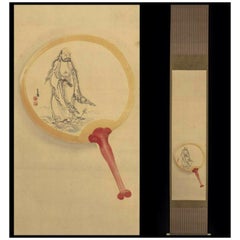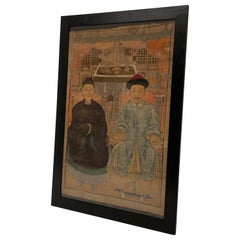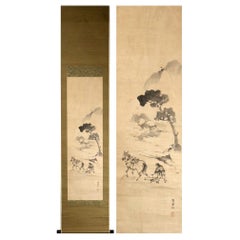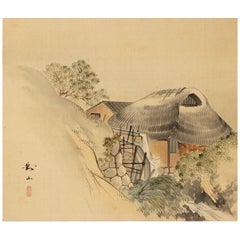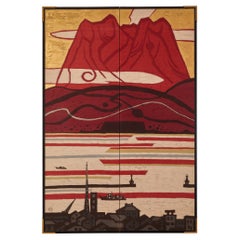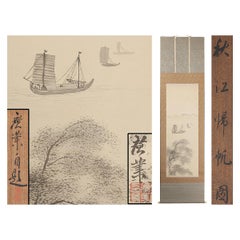East Asian Paintings and Screens
to
250
835
268
1,332
85
7
35
13
11
4
2
1
1
151
555
626
92
244
112
61
34
4
29
12
3
7
17
18
7
2
622
610
563
502
404
1,595
1,424
921
448
132
1,424
1,385
1,398
29
4
3
2
2
Place of Origin: East Asian
Lovely Japanese 18th-19th Century Edo or Meiji Scroll Painting Japan
Located in Amsterdam, Noord Holland
Maruyama–Shijo style painting
C0ndition; Good but some stains.
Overall dimensions: width of about 28.2 cm and Length of about 173.8 cm
Painting width of about 25.5 cm × leng...
Category
19th Century Meiji Antique East Asian Paintings and Screens
Materials
Bronze
$666 Sale Price
20% Off
Chinese Ancestor Portrait
Located in Schellebelle, BE
Beautiful original Chinese Ancestor Portrait
with a Chinese married couple
great faded colors.
Category
18th Century Antique East Asian Paintings and Screens
Materials
Canvas
Farming Rice Fields Scene Meiji Period Scroll Japan 19c Artist Marked
Located in Amsterdam, Noord Holland
The simple country side life is the ideal of the Oriental scholar.
As you can see, the Kishi Renzan agricultural rice field working painting / box is included.
Agricultural rice fields are worked using horses...
Category
Mid-19th Century Meiji Antique East Asian Paintings and Screens
Materials
Silk
$1,189 Sale Price
20% Off
Lovely Late Edo Period Scroll Paintings Japan Artist Landscape Painted
Located in Amsterdam, Noord Holland
Artist: "Hineno Taiyama"
End of the Edo period painter. Osaka production.
Hine Taizan (Hine Taizan, 10 years of culture (1813)-March 13, 1868 (April 24, 1869) is a literary painter...
Category
19th Century Edo Antique East Asian Paintings and Screens
Materials
Silk
$1,094 Sale Price
20% Off
Japanese Two-Panel Screen, Harbor Scene in a Modernist View
Located in Hudson, NY
Bountiful mountain overlooking a city, divided by an occupied river. The shapes and colors that make up this unique painting allow for an unconventional take on a modern harbor view....
Category
Early 20th Century East Asian Paintings and Screens
Materials
Gold, Brass
Scroll Painting Japanese 19th-20th Century Kōgyō Terasaki Meiji
Located in Amsterdam, Noord Holland
A fabulous landscape by Kogyo Terasaki
1866-1919
Japan painter. Akita prefecture production. Character is Tokusato, Soyama-Agaryunoki, beautiful poetry Yamabito, etc. to another is...
Category
20th Century Meiji East Asian Paintings and Screens
Materials
Bronze
$1,249 Sale Price
25% Off
Chinese Framed Water Color of a Man and Woman
Located in Rio Vista, CA
Interesting Chinese framed watercolor depicting a man deep in meditative thought with a woman and two children. Beautifully drawn with intricate details. The man sits on his mat with...
Category
20th Century Mid-Century Modern East Asian Paintings and Screens
Materials
Glass, Wood, Paper
$800 Sale Price
20% Off
Lovely 20th Araki Jippo Scroll Paintings Japan Artist Bird and Tree Painted
Located in Amsterdam, Noord Holland
"Araki jippo"
Japan painter.
Nagasaki prefecture production. First issue is Kinko. Name Teijiro.
Tokyo to study under Kanpo Araki, later it will be the Yoshishi.
You good at flow...
Category
Early 20th Century Edo East Asian Paintings and Screens
Materials
Silk
$1,094 Sale Price
20% Off
Japanese Four Panel Screen Banana Grove
Located in Hudson, NY
Japanese Four Panel Screen: Banana Grove, early Showa period (late 1920s-1930s) painting of life-size fruiting banana trees in a style that ...
Category
Mid-20th Century Showa East Asian Paintings and Screens
Materials
Wood, Paper
Lovely 19th Tamazusa Kawabata Scroll Paintings Japan Artist Crane Painted
Located in Amsterdam, Noord Holland
Tamazusa Kawabata
1842-1913
Japan painter. Kyoto student. His name is Takinosuke, Keitei in another issue, and Kei in his later years. At the age of eleven, he entered the gate of Aki Nakajima, and later learned from Kaikei Oda. After moving to Tokyo, he learned oil painting with Yuichi Takahashi and Wargman. In addition, he became a modern Japanese Maruyama sect who loves Maruyama Okyo...
Category
19th Century Showa Antique East Asian Paintings and Screens
Materials
Silk
$2,998 Sale Price
20% Off
Showa Period Jinmaku Screen
Located in Fukuoka, JP
Showa Jinmaku Screen
Period: Showa
Size: 376x171 cm
SKU: PTA116
Discover the historical charm of our Showa Jinmaku screen, impeccably preserved and in extremely good condition. Jinm...
Category
20th Century Showa East Asian Paintings and Screens
Materials
Wood, Paper
Scroll Kitsuda Eihô (1902 - 1974) Breaking of Dawn in the Mountains Japanese
Located in Amsterdam, Noord Holland
Kitsuda Eihô (1902 - 1974) Aanbreken van de dag in de bergen
Rolschildering / scroll op zijde, houten rollers, in houten cassette. Herkomst: Oranda Jin. B 128 x 41.9 / 202 x 56.3 cm...
Category
Mid-20th Century Meiji East Asian Paintings and Screens
Materials
Silk
$1,570 Sale Price
20% Off
Nightingale on Branch Meiji Period Scroll Japan 19/20c
Located in Amsterdam, Noord Holland
Very Lovely painting.
Category
Mid-19th Century Meiji Antique East Asian Paintings and Screens
Materials
Silk
$1,189 Sale Price
20% Off
BATTLE SCENE AND HUNTING SCENE Late 18th Century Chinese
Located in Madrid, ES
BATTLE SCENE AND HUNTING SCENE Late 18th Century Chinese
Chinese paintings, from the 18th century, on paper. Framed.
Small defects.
Dim.: 177 x 162 cm
Category
Late 18th Century Chinese Export Antique East Asian Paintings and Screens
Materials
Paper
Vintage Victory Cigarettes Advertisement Poster, c. 1930
Located in Chicago, IL
This poster from the 1930s melds the meticulous detail of traditional Chinese painting with the craft of color lithography and a side of risque. Posters like this one, influenced by ...
Category
1930s Vintage East Asian Paintings and Screens
Materials
Paint, Paper
Mid-19th Century Pair of Chinese Gouache Portraits
Located in Chapel Hill, NC
Mid-19th century pair of Chinese portraits painted on rice or pith paper. An official of the Qing dynasty and his wife, set in lushly detailed interiors. From symbols of authority to...
Category
Mid-19th Century Qing Antique East Asian Paintings and Screens
Materials
Paint, Paper
$960 Sale Price / set
20% Off
Meiji Chrysanthemum Masterpiece
Located in Fukuoka, JP
Step into a world of timeless beauty with our exceptional six-panel screen from the Edo-Meiji period. In impeccable condition, each panel features stunning paintings of chrysanthemum...
Category
19th Century Meiji Antique East Asian Paintings and Screens
Materials
Gold
Lovely 20th Yūki Somei Scroll Paintings Japan Artist Bird and tree Painted
Located in Amsterdam, Noord Holland
"Somei Yuki"
1875 (1875) - 1957 (1957)
Tokyo living, Japan painter.
Real name Sadamatsu, maiden name Morita.
Tamazusa Kawabata disciple, Tokyo art school graduation.
Empire Art ...
Category
Early 20th Century Edo East Asian Paintings and Screens
Materials
Silk
$1,094 Sale Price
20% Off
Rare Pair of North Korean Art Paintings – Traditional Drum Dance on Rice Paper
Located in Barueri, SP, BR
Own a piece of history with this authentic pair of North Korean ink paintings, depicting the grace and energy of traditional drum dancing. Created in 1977, these ink-on-rice-paper artworks were originally purchased from a gallery in Pyongyang, making them an exceptionally rare find on the international art market.
Exquisite Traditional Craftsmanship
Each painting showcases a dancer in vibrant traditional Korean attire, masterfully rendered with expressive brushstrokes and delicate detailing. The fluid movement of the flowing garments and the drum’s dynamic presence capture the essence of a time-honoured performance art. Framed in a minimalist black frame with a red border accent, these pieces are ready to be displayed in a collector’s gallery or cultural space.
Why These Paintings Are a Valuable Investment
Authentic North Korean art...
Category
20th Century East Asian Paintings and Screens
Materials
Paper
$5,168 Sale Price / set
20% Off
Lovely 20th Century Tatehiko Kan Scroll Paintings Japan Artist Crane Painted
Located in Amsterdam, Noord Holland
Tatehiko Kan
1878-1968
Tottori Prefecture born
real name: FujiTaro Sugawara
issue: Moritora, Shizuko, Tatehiko
Japan Art Academy Imperial Award, Osaka Art Association member, Os...
Category
19th Century Showa Antique East Asian Paintings and Screens
Materials
Silk
$2,998 Sale Price
20% Off
Lake Awasaru Scene Meiji Period Scroll Japan 19c Artist Marked Nihonga Style
Located in Amsterdam, Noord Holland
As you can see, it is a Japanese painting "Lake Suwa Asaharu" figure / co-box.
It is a "Lake Suwa Asaharu" figure with gentle sunlight, and it is
a very tasty work combined with a ...
Category
Mid-19th Century Meiji Antique East Asian Paintings and Screens
Materials
Silk
$1,189 Sale Price
20% Off
Lovely 20th Century Scroll Paintings Japan Tomobako Showa Artist Kobayashi
Located in Amsterdam, Noord Holland
Great decorated piece, artist Kobayashi Futoshi Gensho (B.1938-now)
Condition:
Very good. Size: Axis, vertical 117 cm horizontal 60.5 cm, painting, vertical 35 cm horizontal 58.5...
Category
20th Century Showa East Asian Paintings and Screens
Materials
Fabric
$1,204 Sale Price
25% Off
Japanese Two-Panel Screen: Geese in a Country Setting
Located in Hudson, NY
Country farm geese with early spring blossoms and a bamboo fence. Beautiful details on the feathers. Signature and seal read Keibo Joshi (Ms. Keibo) min...
Category
Early 20th Century Meiji East Asian Paintings and Screens
Materials
Silk, Wood, Paper
Lovely Scroll Paintings Japan Artist Signed Wakasa Seigyo Monogai "Spring Breeze
Located in Amsterdam, Noord Holland
Wakasa Seigyo "spring breeze garden view", silk, colors, painting, hanging scroll, with box
Size: Axis, vertical 142 cm horizontal 65.5 cm
picture, vertical 44 cm horizontal 50.5...
Category
20th Century Showa East Asian Paintings and Screens
Materials
Silk
$1,026 Sale Price
25% Off
Oil on Canvas Painting "Bath House in Tokyo" by Frances Blakemore
Located in Hudson, NY
Oil on canvas: "Bath House in Tokyo" by Frances Blakemore
Frances Blakemore (1906-1997) was an American artist living for more than 50 years in Japa...
Category
Mid-20th Century East Asian Paintings and Screens
Japanese Two Panel Screen Abstract Design
Located in Hudson, NY
Lacquer on wood. Signature reads: Toshimasa. Solid black lacquer on reverse. Signed original box.
Category
Mid-20th Century East Asian Paintings and Screens
Materials
Lacquer
Japanese Two-Panel Screen, Rimpa Style Chrysanthemums on a Twig Fence
Located in Hudson, NY
Detailed painting of varieties of chrysanthemums behind a bound-twig garden fence rendered in silvered, raised gofun. Stylized low-hanging gold mist clouds. Rimpa-style painting in m...
Category
Late 19th Century Antique East Asian Paintings and Screens
Materials
Gold
Fabulous Landscape by Kōgyō Terasaki 1866-1919 Japan Painter Akita Prefecture
Located in Amsterdam, Noord Holland
Maruyama–Shijo style painting
Condition; Good but some stains.
Overall dimensions: width of about 28.2 cm and Length of about 173.8 cm
Painting width of about 25.5 cm × leng...
Category
19th Century Meiji Antique East Asian Paintings and Screens
Materials
Bronze
$1,142 Sale Price
20% Off
Japanese Two Panel Screen Snow Flakes Falling in the Forest
Located in Hudson, NY
With young bamboo and winter berry in the foreground and footprints in the snow. Mineral pigments and mica on paper. Seal reads: Seikan.
Category
Early 20th Century East Asian Paintings and Screens
Materials
Paper
Chinese Yangliuqing New Year Painting of Beauty and Baby, c. 1920
Located in Chicago, IL
Chinese New Year paintings (nian hua) are colorful folk paintings created to celebrate the annual Spring Festival. Drawn or printed by folk artists in regional studios, nian hua pain...
Category
1920s Folk Art Vintage East Asian Paintings and Screens
Materials
Paper
Japanese Scroll, Chikubu Shima ‘Chikubu Island’
Located in Hudson, NY
Chikubu is an island in Lake Biwa, Shiga prefecture. This painting depicts a tori gate leading to a temple, and in the background is Kyoto and the Higashiyam...
Category
20th Century East Asian Paintings and Screens
Materials
Silk, Wood, Paper
Japanese Two Panel Screen Psychedelic Forms
Located in Hudson, NY
Celestial images on hand-dyed tsumugi cloth. Makers mark: unreadable.
Category
Mid-20th Century East Asian Paintings and Screens
Materials
Fabric
Chinese Sign of Honor, circa 1850
Located in Chicago, IL
Signs of honor were presented as a gesture of gratitude to individuals who had bettered their community or in acknowledge of a respected person’s birthday. The sign would have been h...
Category
Mid-19th Century Qing Antique East Asian Paintings and Screens
Materials
Elm
Taisho Period Calligraphy Screen: The Dragon's Song
Located in Fukuoka, JP
Taisho Period Calligraphy Screen: The Dragon's Song (2/2)
Period: Taisho
Size: 174 x 172.5 cm (68.5 x 67.9 inches)
SKU: PTA77
This calligraphy screen from the Taisho period is ...
Category
20th Century Taisho East Asian Paintings and Screens
Materials
Silver Leaf
Chinese Yangliuqing New Year Painting of Peace & Prosperity, c. 1920
Located in Chicago, IL
Chinese New Year paintings (nian hua) are colorful folk paintings created to celebrate the annual Spring Festival. Drawn or printed by folk artists in regional studios, nian hua pain...
Category
1920s Folk Art Vintage East Asian Paintings and Screens
Materials
Paper
"View from the Terrace, " Mixed-Media by Yamin Young
By Yamin Young
Located in Houston, TX
Well listed Chinese Artist Yamin Young. "View from the Terrace". Mixed-media on handmade rice paper, mounted to the fabric base, protected by the plexiglas...
Category
Late 20th Century Other East Asian Paintings and Screens
Materials
Gold Leaf
Chinese Yangliuqing New Year Painting of Beauty and Baby, c. 1920
Located in Chicago, IL
Chinese New Year paintings (nian hua) are colorful folk paintings created to celebrate the annual Spring Festival. Drawn or printed by folk artists in regional studios, nian hua pain...
Category
1920s Folk Art Vintage East Asian Paintings and Screens
Materials
Paper
Pair of Japanese Modern Bamboo Room Dividers Screens Decorative Panels Wall Art
Located in Rockaway, NJ
Pair of Japanese Modern Bamboo Room Dividers Screens Decorative Panels Wall Art
Category
20th Century East Asian Paintings and Screens
Materials
Bamboo
Japanese Silk Suijaku Scroll Nyorai-Kojin with Mixed Buddhism and Shinto Deities
Located in Atlanta, GA
A Japanese silk Suijaku hanging scroll beautifully presented in a custom wood shadow box frame from Edo period (circa 18-19th century). The scroll, surmounted on golden brocade was painted in fine details with gouache, ink and gold powder highlight, served as a Suijaku mandala for the worshippers. Honji Suijaku is a complicated religious concept uniquely developed in Japan. It mixed and hybrid the Buddism deities with native shinto spirits (known as Kami), which were seen as local manifestations (the suijaku, literally means a "trace") of Buddhist deities (the honji literally the original ground). The original idea may lie with the synergetic strategy to spread Buddism by making it more relatable to the local population who had already worshiped Shinto gods. The paradigm, adopted in the 10th century from an orignal Chinese concept, remained a defining feature of Japanese religious life up to the end of the Edo period (1868). Instead of being confined to deities, its application was often extended to historical figures as shown on this scroll.
This long hanging scroll depicts an arrangement of 21 figures including Buddhism and Shinto deities as well as two historical figures on the bottom. Each figure was name-tagged in Kanji for easy identification by the worshippers. It was used in the temple or shrine so that when the worshipper prayed in front the mandala, they prayed simultaneously to all the deities.
On the very top, sits Nyorai-Kojin, a hybrid deity of Nyorai Buddha and Kojin, the kaki for fire, stove and kitchen. From the top to bottom and left to right, here is the list of the deities: Kanon with Thousand Hands, Kanon with Willow Branch, Monju Bosatsu...
Category
Early 19th Century Edo Antique East Asian Paintings and Screens
Materials
Silk, Wood
Chinese Folk Drawing of Mythical Qilin, c. 1900
Located in Chicago, IL
Beautifully detailed and masterfully painted, this painting dating from the turn of the 20th century centers its expressive composition upon a rondel of Chinese symbols. Representing...
Category
Early 20th Century Qing East Asian Paintings and Screens
Materials
Muslin, Elm
$1,176 Sale Price
30% Off
Pair Antique 19th Century 1880 Chinese Gouaches on Rice Paper Geisha Girl & Lord
Located in West Sussex, Pulborough
We are delighted to offer for sale this lovely pair of antique circa 1880’s Chinese hand painted Gouache paintings depicting a Geisha girl and Lord
A very good looking and beautifully painted pairing, they were made for the export market during the British colonialism...
Category
1880s Chinese Export Antique East Asian Paintings and Screens
Materials
Paper
Autumn Sowing
Located in Hudson, NY
Gouache painting on paper of farmers tilling and sowing a field, by Ton Yan Kui. Unsigned with label from A.M. Adler Fine Art, NY. Comes framed.
Category
1970s Vintage East Asian Paintings and Screens
Materials
Paper
$1,800
Antique kimono textile art " Kobachi ~ Coral Collection ~ " by ikasu Pink, Japan
By Kimono ikasu
Located in Setagaya City, JP
This work is inspired by the coral color palette, and is framed in paulownia wood originally used for a kimono chest-of-drawers.
In this artwork, the aim was to capture the wide pal...
Category
1920s Japonisme Vintage East Asian Paintings and Screens
Materials
Silk, Wood
Set of Four Sliding Doors (Fusuma): Bamboo on Gold
Located in Hudson, NY
Meiji period (1868 - 1912) four separate fusuma doors (sliding doors) with paintings of bamboo trees. Can be hung separately, or together as shown. Signature in the process of bein...
Category
Late 19th Century Antique East Asian Paintings and Screens
Materials
Gold, Bronze, Gold Leaf
Framed Korean Folk Shamanistic Painting of Seven Stars
Located in Atlanta, GA
A Korean folk painting watercolor on linen (silk) with a cloth mat and walnut wood frame. The work is in the shamanistic style and depicts the Tao...
Category
Early 20th Century Folk Art East Asian Paintings and Screens
Materials
Textile
'Love and Lotus Boys' Early 20th Century Chinese Folk Painting
Located in Chicago, IL
Drawn with a fine line and fresh, sketched quality, this folk hanging unites two scenes of lucky hoho lotus boys circumscribed in frames punctuated with fruits such as pomegranate, symbolic of prosperity and good fortune. On top, the two explore the natural wonders of the world...
Category
Early 20th Century Qing East Asian Paintings and Screens
Materials
Wood, Linen
Japanese Modern Abstract Ink Painting
Located in Hudson, NY
On mulberry paper with silk brocade. From the estate of Andrea Bollt. Artist's seal reads: Mitsushito (died 1922).
Category
Early 1900s Antique East Asian Paintings and Screens
Materials
Brocade, Silk, Paper
Vintage obi textile art " Camellia ~ Serendipity ~ " by ikasu Blue, Japan
By Kimono ikasu
Located in Setagaya City, JP
This work is inspired by traditional Japanese nature motifs symbolism, and is framed in paulownia wood originally used for a kimono chest-of-drawers.
In this artwork, the aim was to capture the the auspicious symbol of camellia used in antique kimono. Traditional Japanese culture, represented by the kimono, and wood, an integral element of Japanese craftsmanship, were used to bring this vision to life.
I used pieces of kimono that could no longer be used as clothing and kiritansu chest-of-drawers that would normally be discarded to create the ultimate upcycled piece.
<< Explanation and meaning of pattern and colors >>
This delicate piece features hand-drawn camellia motifs flowing gracefully on a softly brightened grayish background.
Camellias, native to Japan, bloom from winter to early spring. As an evergreen tree with green leaves throughout the year, it symbolizes the anticipation of spring and is considered an auspicious plant. Due to its seasonal significance and auspicious meanings, camellias have been used as motifs symbolizing good fortune. Additionally, they were highly valued for their use in oil, cosmetics, and medicine, representing nobility. Believed to possess the power to ward off misfortune, camellias also carry the meaning of "protection from calamity" and have strong ties to traditional ceremonies. In this artwork, camellias are delicately depicted alongside flowing branches, subtly representing good fortune with their pale pink and white hues.
"Sora-iro nezumi 空色鼠" refers to a light grayish color with a hint of blue, reminiscent of the slightly brightened sky on a lightly cloudy day. Popular during the late Edo period (19th cent.), it elegantly captures the slightly brighter sky pattern seen on lightly overcast days. Notably, the term "nezumi-iro" (mouse gray), popular during the late Edo period, was paired with brown tones, collectively known as "Forty-eight Teas and a Hundred Mice 四十八茶百鼠." Colors within the "nezumi" (gray) spectrum, particularly "sora-iro nezumi," were favored by young people for their cool and sophisticated appeal.
<< Characteristics of the fabric >>
The fabric features intricately woven patterns that reveal subtle gradations through dyeing, creating a grid pattern that transforms depending on the light conditions.
Originally, this fabric was part of a formal kimono known as a "hōmongi 訪問着," featuring motifs along the hem, shoulders, and sleeves. These motifs have been carefully selected and combined to create a unified piece of artwork.
<< About the frame >>
Kiritansu - chest-of-drawers for kimono, is traditionally made from paulownia wood, a uniquely Japanese material closely tied to the world of kimonos.
Paulownia wood is known as the lightest wood in Japan, prased for its natural luster, resistance to moisture, and resilience against cracking. Since ancient times, it has been used in crafting furniture, chests, and musical instruments.
During the Edo period, it became customary to store cherished kimonos in paulownia chests...
Category
1960s Japonisme Vintage East Asian Paintings and Screens
Materials
Silk, Wood
Large Antique Zen Japanese Ink Scroll After Sesson Shukei
Located in Atlanta, GA
A Japanese Sumi ink painting with light color wash mounted with brocade borders as a hanging scroll (Kakejiku). The painting depicts the famously eccentric Buddhist monks Hanshan and Shide (known in Japan as Kanzan and Jittoku). Often as a pair, they have been a popular motif in Japanese Zen painting...
Category
18th Century Japonisme Antique East Asian Paintings and Screens
Materials
Silk, Paper
1950s Japanese People Drawing w/ Giltwood Frame
Located in Marbella, ES
Original 1950s Japanese people drawing with giltwood frame
Frame measurements: 32x42x1cm.
Category
Late 20th Century East Asian Paintings and Screens
Materials
Paper
"We" by Ren Hui
By Ren Hui
Located in Chicago, IL
This exquisite woodcut, “We,” was made by internationally renowned Chinese artisan Ren Hui. His artworks reflect the artist’s richness of experience: he’s been a soldier, factory wor...
Category
21st Century and Contemporary East Asian Paintings and Screens
Materials
Wood, Paint
$1,980
Monumental Chinese Early to Mid 20th Century Hand Painted 4 Panel Folding Screen
Located in Milford, NH
A monumental Chinese hand painted polychrome canvas on wooden frame four panel folding screen featuring village scenes and figures on both sides, with rolling hills and trees. The sc...
Category
Mid-20th Century East Asian Paintings and Screens
Materials
Canvas, Wood, Paint
Chinese Chinoiserie Black Lacquered and Gold Coromandel 6 Panel Screen
Located in West Hartford, CT
Spectacular Chinese black lacquered 6 panel folding screen incised with gold gilt and white paint featuring Chinese village scenery. Feet...
Category
Mid-20th Century Chinese Export East Asian Paintings and Screens
Materials
Wood, Lacquer
$3,360 Sale Price
20% Off
Vintage obi textile art "Broken Vase ~kintsugi~" by ikasu Black / Gold, Japan
By Kimono ikasu
Located in Setagaya City, JP
This textile artwork uses a vintage obi dated around 1980ies, with a feather motif, and arranges it so that it looks like a vase.
Antique obi, just as it is a broken vase, is united back again with black obijime - a string used to tie up obi when it’s worn. Framed in kiritansu (antique chest) paulownia wood.
It is elegantly framed with paulownia wood originally used for kimono chest-of-drawers, and is filled with storytelling and sense of luxury.
I used pieces of kimono that could no longer be used as clothing and kiritansu chest-of-drawers that would normally be discarded to create the ultimate upcycled piece.
<< Explanation and meaning of pattern and colors>>
Feathers hold various meanings and symbolism in Japanese traditional culture, often reflecting themes of spirituality, symbolism, and folklore. Here are some of the meanings associated with feathers in Japanese tradition:
・Divine Protection: Feathers are often seen as symbols of divine protection and spiritual guidance. Feathers, especially those from birds, are considered to be imbued with the protective energy, offering spiritual guardianship and safeguarding against negative forces.
・Connection to the Spirit World: Feathers are sometimes associated with the spirit world and the realm of the divine. In folklore and mythology, feathers are depicted as messengers between the earthly realm and the celestial realms.
・Symbol of Beauty and Elegance: Feathers are admired for their natural beauty, grace, and elegance. In traditional Japanese arts such as Noh theater, Kabuki, and dance performances like Kagura, actors and performers often use feathered costumes or accessories to enhance their appearance and convey a sense of refinement and sophistication.
・Sign of Good Luck and Prosperity: In Japanese folklore, certain birds like cranes and pheasants are considered symbols of good fortune, longevity, and prosperity. Feathers from these birds are often depicted in art and craftwork as auspicious symbols believed to bring blessings and positive energy to the bearer.
<>
Kiritansu - chest-of-drawers for kimono, is traditionally made from paulownia wood, a uniquely Japanese material closely tied to the world of kimonos.
Paulownia wood is known as the lightest wood in Japan, prased for its natural luster, resistance to moisture, and resilience against cracking. Since ancient times, it has been used in crafting furniture, chests, and musical instruments.
During the Edo period, it became customary to store cherished kimonos in paulownia chests...
Category
1980s Japonisme Vintage East Asian Paintings and Screens
Materials
Silk, Wood
Early 19th Century Japanese Scroll Bijin after the Bath in Summer
Located in Hudson, NY
Early 19th century Japanese Scroll: Bijin after the bath in summer. Painted in pigments on silk. Signature reads: Yamauchi Sentsu.
Japan,...
Category
Early 19th Century Edo Antique East Asian Paintings and Screens
Materials
Silk, Wood
Antique Japanese Hanging Scroll Attributed to Iwasa Matabei
Located in Atlanta, GA
An antique ink and color on paper hanging scroll (kakejiku) with brocade border. It appears to be a fragment of a larger hand scroll depicting a procession of a lord with his entoura...
Category
Early 17th Century Japonisme Antique East Asian Paintings and Screens
Materials
Silk, Paper
Vintage kimono textile art "Fern ~Connection to Nature~" by ikasu Black , Japan
By Kimono ikasu
Located in Setagaya City, JP
This work uses an antique tomesode (festive kind of kimono) with fern design to evoke feelings of tranquility, harmony, and appreciation for the beauty of the environment. Can be used both vertically and horizontally.
It is elegantly framed with paulownia wood originally used for kimono chest-of-drawers, and is filled with storytelling and sense of luxury.
I used pieces of kimono that could no longer be used as clothing and kiritansu chest-of-drawers that would normally be discarded to create the ultimate upcycled piece.
<< Explanation of colors and patterns >>
In Japanese traditional culture, ferns, particularly the Japanese painted fern (Athyrium niponicum), hold several meanings and symbolisms:
・Elegance and Beauty: Ferns are admired for their graceful, delicate appearance and intricate leaf patterns. In Japanese aesthetics, they are appreciated for their natural beauty and are often used in gardens, landscapes, and floral arrangements to add a sense of refinement and elegance.
・Resilience and Perseverance: Ferns are known for their ability to thrive in diverse environments, including shady forests, rocky cliffs, and damp soil. Their resilience in the face of challenging conditions is seen as a symbol of endurance and perseverance. In Japanese culture, ferns may represent the ability to overcome adversity and flourish despite obstacles.
・Connection to Nature and Tranquility: Ferns are native to forested areas and are often associated with the natural world. In Japanese traditional culture, they symbolize a deep connection to nature and the importance of maintaining harmony with the environment. The lush green foliage of ferns evokes feelings of tranquility and peacefulness, making them popular motifs in Zen gardens and traditional landscape paintings.
・Purity and Simplicity: Ferns are emblematic of simplicity and purity in Japanese aesthetics. Their unassuming beauty and understated elegance reflect the principles of wabi-sabi, an aesthetic worldview that values imperfection, impermanence, and simplicity. Ferns may be used in tea ceremonies, Ikebana (flower arranging), and other traditional arts to evoke a sense of tranquility and appreciation for life's fleeting moments.
Overall, ferns in Japanese traditional culture symbolize elegance, resilience, connection to nature, purity, and simplicity. Their presence in art, literature, and landscape design underscores their enduring significance as symbols of natural beauty and spiritual resonance.
<< Characteristics of the fabric >>
This vintage textile is hand-painted with a traditional Japanese technique called "yuzen".
<< About the frame >>
Kiritansu - chest-of-drawers for kimono, is traditionally made from paulownia wood, a uniquely Japanese material closely tied to the world of kimonos.
Paulownia wood is known as the lightest wood in Japan, prased for its natural luster, resistance to moisture, and resilience against cracking. Since ancient times, it has been used in crafting furniture, chests, and musical instruments.
During the Edo period, it became customary to store cherished kimonos in paulownia chests...
Category
1960s Japonisme Vintage East Asian Paintings and Screens
Materials
Silk, Wood
Framed Shakyamuni Buddha Thangka Painting
Located in Miami, FL
Offered is a vibrant and intricate Tibetan Buddhist "thangka" (also known as "tangka", "thanka", or "tanka"), which is what a painting that serves as a visual representation of spiri...
Category
1960s Tibetan Vintage East Asian Paintings and Screens
Materials
Bronze, Gold Leaf
Japanese Six Panel Screen: Black and Gold Lacquer Flower Festival Cart
Located in Hudson, NY
Abundant flower arrangement of peonies in a basket, with a four legged rest to the right and a twig fence to the left. Fine lacquer ceremonial cart with silk ties and areas of raised...
Category
Early 19th Century Antique East Asian Paintings and Screens
Materials
Gold Leaf
Japanese Two Panel Screen South Seas Fire Dancers
Located in Hudson, NY
Ink and color on buff ground, on paper. reads: Nankaino omoide (memory of south sea) signature and seal read: Katsuyuki. Very unusual subject matter.
Category
Early 20th Century East Asian Paintings and Screens
Materials
Paper
Recently Viewed
View AllMore Ways To Browse
Japanese Red Lacquer Frame
Lattice Panel Wood
Hanging Japanese Screen
Japanese Lattice
Japanese 19th Century Meiji Period Silk Painting
Japanese Buddhist Screen
Japanese Carved Screen
Japanese Screens And Doors
Monkey Screen
Japanese Autumn Screen
Japanese Screens Six Fold
Japanese Wood Room Divider
Kyoto Silk Painting
Japanese Dragon Painting
Japanese Birds Painted On Silk
Heian Period
Japanese Crane Panel
Japanese Divider Screen
